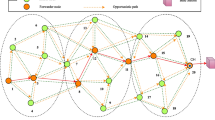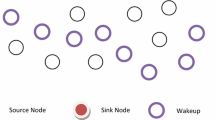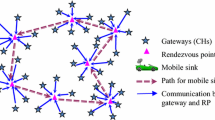Abstract
In large-scale applications in science and business space require the exchange of enormous information over high performance systems for remote tasks. In wireless sensor networks, the sensor planning is a appropriate set up for controlling the node energy utilization and expanding network coverage lifetime. The task is to decide a proper planning component for the nodes with the end goal to keep up adequate check of dynamic nodes for maximum network coverage. In this paper we demonstrate the node scheduling algorithm and discuss about the transmission scheduling technique. The node can be described in various level of simulation with described active nodes. The life time of the active node will describes in the simulation diagram. The scheduling technique of the node can be clearly defined in the proposed algorithm to communicate the information of the node within the clusters. Moreover the proposed dynamic model node scheduling algorithm to schedule the node within in the cluster region. And we propose the few techniques of OBSP to know the status of the node and its various levels. In our work we clearly demonstrate the three states of the node. The cluster connection will be done with the help of the gateway node.











Similar content being viewed by others
References
Lu, Y., Zhang, T., He, E., & Comşa, I. S. (2018). Self-learning-based data aggregation scheduling policy in wireless sensor networks. Journal of Sensors, 2018, 12.
Murugaanandam, S., & Ganapathy, V. (2019). Reliability-based cluster head selection methodology using fuzzy logic for performance improvement in WSNs. IEEE Access, 7, 87357.
Yen, L. H., Law, Y. W., & Palaniswami, M. (2012). Risk-aware distributed beacon scheduling for tree-based ZigBee wireless networks. IEEE Transactions on Mobile Computing, 11(4), 692–703.
Marsan, M. A., Chiasserini, C. F., Nucci, A., Carello, G., & De Giovanni, L. (2002). Optimizing the topology of bluetooth wireless personal area networks. In Proceedings of the INFOCOM 2002, twenty-first annual joint conference of the IEEE computer and communications societies (vol. 2, pp 572–579). IEEE.
Chen, Y. S., & Lin, T. H. (2007). A time-slot leasing-based QoSrouting protocol over Bluetooth WPANs. International Journal of Ad Hoc and Ubiquitous Computing, 2(1), 92–108.
Giri, D., & Roy, U. K. (2009). Address borrowing in wireless personal area network. In IEEE international advance computing conference, (IACC 2009), (pp 181–186). Patiala.
Zheng, J., & Lee, M. J. (2006). A comprehensive performance study of IEEE802.15.4, sensor network operations (pp. 218–237). Hoboken: IEEE Press.
Lee, J.-S. (2006). Performance evaluation of IEEE 802.15. 4 for low-ratewireless personal area networks. IEEE Transactions on Consumer Electronics, 52(3), 742–749.
Al-Harbawi, M., Rasid, M. F., & Noordin, N. K. (2009). Improved treerouting (ImpTR) protocol for ZigBee network. International Journal of Computer Science and Network Security, 9(10), 146–152.
Cuomo, F., Luna, S. D., Monaco, U., & Melodia, T. (2007). Routing in ZigBee: Benefits from exploiting the IEEE 802.15.4 association tree. IEEE international conference on communications 2007 (ICC'07).
Chéour, R., Jmal, M. W., Kanoun, O., & Abid, M. (2017). Evaluation of simulator tools and power-aware scheduling model for wireless sensor networks. IET Computers & Digital Techniques, 11(5), 2017.
Sanchez, C. A., Mokrenko, O., Zaccarian, L., & Lesecq, S. (2018). A hybrid control law for energy-oriented tasks scheduling in wireless sensor networks. IEEE Transactions on Control Systems Technology, 26(6), 95.
Jothikumar, C., & Venkataraman, R. (2019). EODC: An energy optimized dynamic clustering protocol for wireless sensor network using PSO approach. International Journal of Computers Communications & Control, 14(2), 183–192.
Kelner, J. M., & Ziółkowski, C. (2019). Comments on “A Three-Dimensional Geometrical Scattering Model for Cellular Communication Environment”. Wireless Personal Communications, 108, 1481–1491. https://doi.org/10.1007/s11277-019-06480-1.
Lipiński, Z. (2018). Routing algorithm for maximizing lifetime of wireless sensor network for broadcast transmission. Wireless Personal Communications, 101, 251–268. https://doi.org/10.1007/s11277-018-5686-5.
More, A., & Wagh, S. (2015). Energy efficient coverage using optimized node scheduling in wireless sensor networks. In 2015 1st international conference on next generation computing technologies (NGCT).
Xin-lian, Z., & Bo, G. (2008). Intra-cluster nodes scheduling algorithm satisfying expected coverage degree of application in distributed clustering WSNs. In: 2008 international conference on computer science and software engineering.
Zhang, H. (1995). Service disciplines for guaranteed performance service inpacket-switching networks. Proceedings of the IEEE, 83(10), 1374–1396.
Heinzelman, W. B., Chandrakasan, A. P., & Balakrishnan, H. (2002). An application-specific protocol architecture for wireless microsensor networks. IEEE Transactions on Wireless Communications, 1(4), 660–770.
More, A., & Raisinghani, V. (2014). Random backoff sleep protocol for energy efficient coverage in wireless sensor networks. Smart Innovation, Systems and Technologies, 28(2), 323–331.
Huang, Y. K., Pang, A. C., Hsiu, P. C., Zhuang, W., & Liu, P. (2012). Distributed throughput optimization for ZigBee cluster tree networks. IEEE Transactions on Parallel and Distributed Systems, 23(3), 513–520.
Saleh, A. B., Sibley, M. J., Mather, P. (2014). Energy efficient cluster scheduling and interference mitigation for IEEE 802.15.4 network. In 2014 international computer science and engineering conference (ICSEC).
Sakthy, S. S., & Bose, S. (2019). Optimising residual energy transmission head with SNR value in multiple clusters. Wireless Personal Communications, 108(1), 107–120.
Jayarajan, P., Kanagachidambaresan, G. R., Sundararajan, T. V. P., et al. (2018). An energy-aware buffer management (EABM) routing protocol for WSN. The Journal of Supercomputing. https://doi.org/10.1007/s11227-018-2582-4.
Author information
Authors and Affiliations
Corresponding author
Additional information
Publisher's Note
Springer Nature remains neutral with regard to jurisdictional claims in published maps and institutional affiliations.
Rights and permissions
About this article
Cite this article
Susila Sakthy, S., Bose, S. Dynamic Model Node Scheduling Algorithm Along with OBSP Technique to Schedule the Node in the Sensitive Cluster Region in the WSN. Wireless Pers Commun 114, 265–279 (2020). https://doi.org/10.1007/s11277-020-07362-7
Published:
Issue Date:
DOI: https://doi.org/10.1007/s11277-020-07362-7




